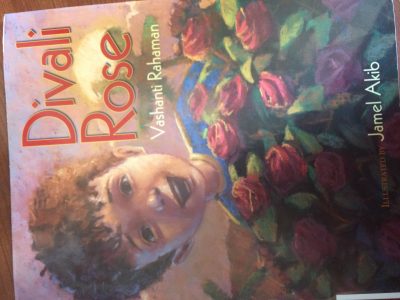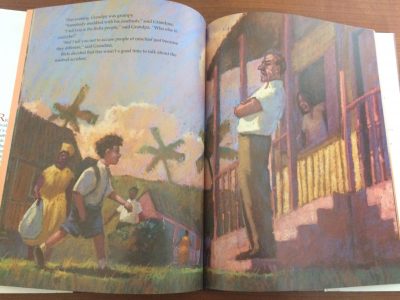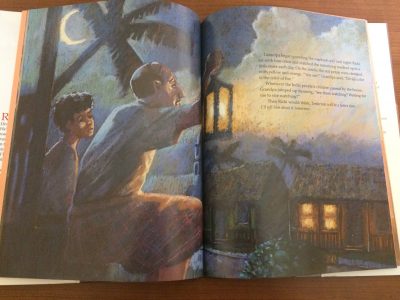Divali Rose
Written by Vashanti Rahaman
Illustrated by Jamel Akib
Boyds Mills Press, 2008
27 pages, Realistic Fiction
Divali Rose is the story of a boy named Ricki who learns about stereotypes and overcoming hatred when he experiences prejudice from his grandfather. In the days before Divali, Ricki looks at his grandfather’s rose bush to see what color the roses will be, but he accidentally breaks one of the roses off. When his grandfather sees that one of the roses is missing, he immediately accuses one of the “India people,” his name for a group of new immigrants from India to Trinidad. Ricki is afraid of his grandfather’s anger, so he does not tell him that he was the one who took the rose, but as Ricki hears his grandfather speak about the India people, he begins to question why his grandfather has so much hatred for someone who is Indian, just like they are. As Ricki and his grandfather talk, his grandfather begins to see that his views are limiting, and he apologizes to their neighbors, at which time Ricki confesses his involvement with the roses.
This story can be seen as both a window and a mirror for a great number of students. This book provides a look into island life and Hindu festivals, which young children might not be familiar with. However, the conflict between neighbors and slightly different groups of people can be a mirror for many students. Although upper elementary school children can handle this material, this book would also be appropriate for middle or high school children to examine and discuss, especially with ideas of immigration and acceptance. Ricki points out that his great-grandparents who came to Trinidad from India over one hundred years ago are not much different than the “India people” who just immigrated from India as well, which can be connected to anti-immigration sentiments today. By having the protagonist see the error in the old ways of thinking, children and adults alike can see how anti-immigration rhetoric does not make sense and is deeply flawed. Divali Rose can also serve as a mirror for students who are of Indian decent, practice the Hindu religion, who are familiar with the island of Trinidad, or who are immigrants or the children of immigrants.
Divali Rose was illustrated by Jamel Akib, who used oil pastels to illustrate the text. Akib focuses primarily on the backgrounds of the illustrations, with particular emphasis on the scenery of Trinidad. In many of the illustrations, only Ricki’s face is fully shown, which emphasizes the fact that he is the character who can see the hypocrisy in the treatment of others. Although the entire Festival of Lights is not portrayed in the illustrations, the family is depicted as preparing for the first night of Divali, which is when one of the younger neighbors brings over a dish of sweet milk curds, syrup, and rose petals.
At the end of Divali Rose, Rahaman includes an author’s note where she explains more information about Divali, Trinidadians, and the language that Ricki and his family speak, which is a dialect of English separate from Standard English.



